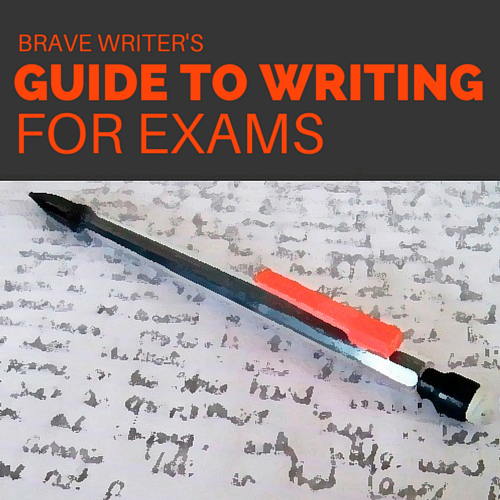Writing for Exams
The SAT/ACT is now including an essay portion. I just taught an online course to help students with preparation for that test. I love timed essays, believe it or not. I took all kinds of essay tests in college and they were my favorites. I had an advanced composition teacher in high school who made us write fifty minute essays for six weeks straight, every single day. I got a C on my first and by the end was easily earning As. I “got” it through practice and some guidance.
For those of you who follow the Brave Writer philosophy, you are already ahead of many of your homeschooled peers with respect to timed writing. Can you think why? Because you’ve been freewriting with a timer for years. That timer has taught your kids how to face the blank page and dive into writing. Their freewrites will develop into more and more complex tangles of thoughts if they are in the freewriting habit and learn how to think and discuss and develop their thinking through all the things we do in Brave Writer. Some of your teens will become good at expressing their ideas in live journals and blogs.
To hone these raw thoughts into an essay format without the benefit of revision is the tricky part. Of course. And it’s also a bit ridiculous from my perspective. There is no other time of life that judges your writing without reference materials, revision opportunities and the eye of an editor. But, this is the method of choice for college (and end of the year exams for younger kids) so we press forward.
The plan
The key to timed writing, then, (after learning how to freewrite comfortably) is to have a plan. I tell my students:
“Make a plan, follow your plan, stick to your plan.”
The plan is your quick outline that you write before you start answering the question. To make a plan, think three.
You should have one clear point you want to make that responds to the question (we call that “the thesis”). But then you need three examples that will support the point.
For instance, if the question asks what you will put in a time capsule for children 100 years from now (like last Friday’s freewrite prompt), the child will think about what areas she’d like to reveal to those in the future: popular music, big news events, famous movie stars. Then she will write an essay that goes through each of those one at a time, explaining her choices.
Let’s say the question asks for whether or not the student agrees that failure leads to success. The student will need to decide if he agrees or not with that assertion (the thesis) and then will choose three examples to support that viewpoint.
For a simple way to come up with three examples, tell your kids to mine their knowledge base. What do they know the most about? Look for a subject area that is personal and deep (basketball, Lord of the Rings, Jane Austen books, origami, Eagle Scouts, raising chickens, WWII, computer programming…) and then try to find three examples within that subject area.
Don’t fall into the trap of most teens, using cliched examples from history or pop culture (such as the Wright brothers, Henry Ford, Thomas Edison, Hitler and so on). If one of these is of personal interest to your teen and he’s studied it because he cares about it, then he can use the example because it will reveal a deeper knowledge of the topic than the typical trite facts associated with it.
Essay structure
The basic structure of the timed essay is one paragraph to get in (include a personal anecdote that shows why you feel connected to the topic, why you care about it, and state your thesis and what your examples will be), three paragraphs to develop the thesis using your plan (and examples), include transitions, and one paragraph to get out (sum up the point you were trying to make and offer a comment on the subject).
Your child’s initial essays will be rough and ragged. That’s normal. Practice is the key.
The key to timed writing: make a plan, follow your plan, stick to your plan.
I remind students to make a plan, follow the plan and stick to the plan because initially it is tempting to run off after some mental flurry of activity and think that is the same as good writing. It usually isn’t. Clarity and organization trump flights of fancy in timed assessment essay writing.
–julie
Image by Kiran Foster (cc cropped, dry brush, text added)
Tags: essay writing, test prep




















[…] Brave Writer’s Guide to Writing for Exams […]